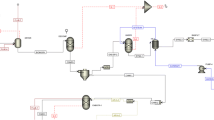Abstract
MixAlco is a robust process that converts biomass to fuels and chemicals. A key feature of the MixAlco process is the fermentation, which employs a mixed culture of acid-forming microorganisms to convert biomass components (carbohydrates, proteins, and fats) to carboxylate salts. Subsequently, these intermediate salts are chemically converted to hydrocarbon fuels (gasoline, jet fuel, and diesel). This work focuses on process synthesis, simulation, integration, and cost estimation of the MixAlco process. For the base-case capacity of 40 dry tonne feedstock per hour, the total capital investment is US $5.54/annual gallon of hydrocarbon fuels (US $3.79/annual gallon of ethanol equivalent), and the minimum selling price [with 10% return on investment (ROI), internal hydrogen production, and US $60/tonne biomass] is US $2.56/gal hydrocarbon, which is equivalent to US $1.75/gal ethanol. If plant capacity is increased to 400 tph, the minimum selling price of biomass-derived hydrocarbon fuels is US $1.76/gal hydrocarbon (US $1.20/gal ethanol equivalent), which can compete without subsidies with petroleum-derived hydrocarbons when crude oil sells for about US $65/bbl. At 40 tph, using the average tipping fee for municipal solid waste (US $45/dry tonne) and current price of external hydrogen (US $1/kg), the minimum selling price is only US $1.24/gal hydrocarbon (US $0.85/gal ethanol equivalent).















Similar content being viewed by others
References
Holtzapple M, Davison R, Ross M, Aldrett-Lee S, Nagwani M, Lee C-M, Lee C, Adelson S, Kaar W, Gaskin D, Shirage H, Chang N-S, Chang V, Loescher M (1999) Biomass conversion to mixed alcohol fuels using the MixAlco process. Appl Biochem Biotechnol 79(1):609–631
Lau MH, Richardson JW, Outlaw JL, Holtzapple MT, Ochoa RF (2006) The economics of ethanol from sweet sorghum using the MixAlco process
Granda C, Holtzapple M, Luce G, Searcy K, Mamrosh D (2009) Carboxylate platform: The MixAlco process part 2: process economics. Appl Biochem Biotechnol 156(1):107–124
Aspen Plus (2007) Aspen Technology, Inc
Aspen Icarus Reference Guide V7.1 (2009) Aspen Technology, Inc, Cambridge
Lara JR, Noyes G, Holtzapple MT (2008) An investigation of high operating temperatures in mechanical vapor-compression desalination. Desalination 227(1–3):217–232
Chang NS (1994) The kinetics studies of enzymatic cellulose hydrolysis and catalytic ketone hydrogenation, in chemical engineering. PhD dissertation, Texas A&M, College Station, Texas
Capareda S (2010) College Station, Texas
Aden A, Ruth M, Ibsen K, Jechura J, Neeves K, Sheehan J, Wallace B, Montague L, Slayton A, Lukas J (2002) Lignocellulosic biomass to ethanol process design and economics utilizing co-current dilute acid prehydrolysis and enzymatic hydrolysis for corn stover. National Renewable Energy Laboratory, Golden, Colorado
LePori WA, Soltes EJ (1985) Thermochemical conversion for energy and fuel. In: Hiler EA, Stout BA (eds) Biomass energy: a monograph. TAMU Press, College Station, pp 9–49
Parkash S (2003) Refining processes handbook. Elsevier, Amsterdam, pp 173–175
Walas SM (1988) Chemical process equipment selection and design. Butterworth, London
Peters MS, Timmerhaus KD, West RE (2003) Plant design and economics for chemical engineers, 5th edn. McGraw-Hill Professional, New York
Spot prices of crude oil and petroleum products (2010) April 6th, 2010 [cited; March 31st, 2010]. Available from http://tonto.eia.doe.gov/dnav/pet/pet_pri_spt_s1_m.htm
Acknowledgments
The authors gratefully acknowledge the sponsorship and collaborations of Dr. Cesar Granda, DARPA, Logos Tech, Terrabon, Valero, and Waste Management.
Legal disclaimer
Except as expressly referenced in this paper, the information, estimates, projections, calculations, and assertions expressed in this paper have not been endorsed, approved, or reviewed by any unaffiliated third party, including Terrabon, Inc., and are based on the authors’ own independent research, evaluation, and analysis. The views and opinions of the authors expressed herein do not state or reflect those of such third parties, and shall not be construed as the views and opinions of such third parties.
Author information
Authors and Affiliations
Corresponding author
Additional information
An erratum to this article can be found at http://dx.doi.org/10.1007/s10295-010-0800-z
Rights and permissions
About this article
Cite this article
Pham, V., Holtzapple, M. & El-Halwagi, M. Techno-economic analysis of biomass to fuel conversion via the MixAlco process. J Ind Microbiol Biotechnol 37, 1157–1168 (2010). https://doi.org/10.1007/s10295-010-0763-0
Received:
Accepted:
Published:
Issue Date:
DOI: https://doi.org/10.1007/s10295-010-0763-0




